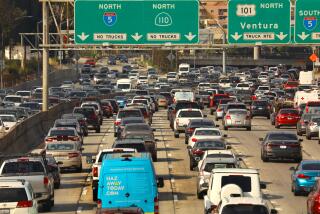AutoNation second-quarter profit jumps 52% on slight sales gain
In an example of how prices for new and used cars have soared this year, the nation’s largest chain of auto dealerships posted a huge gain in profit even though the number of cars it sold rose only slightly.
AutoNation Inc., which operates 254 new vehicle franchises in 15 states, said net income rose 52% to $71.9 million in the second quarter compared with the same period a year earlier. Revenue rose 8% to $3.3 billion.
The price spike is a result of the Japanese earthquake and tsunami in March, which upended auto production internationally by slashing the supply of auto parts needed to manufacture cars and shuttering factories. That slashed the availability of many cars, especially Toyotas and Hondas, and dealers began to raise prices, said Mike Jackson, AutoNation’s chief executive.
“This is momentary. As the Japanese shipments improve during the third quarter, these margins won’t be as strong,” Jackson said.
But Jackson said dealers have regained some control over pricing after years of heavy discounting by the industry. And barring an economic disruption that could occur if Congress and the Obama administration don’t resolve the federal debt ceiling crisis, the auto industry should continue on a “slow but steady recovery,” he said.
Although AutoNation sold just 2.5% more vehicles in the second quarter, each auto went out the door for more money, creating large profit. New cars on average carried nearly 26% more profit than a year earlier — $539. The average profit on a used car jumped $174, or almost 11%. AutoNation’s average selling price for a new car rose $1,747, or 5.5%, to $33,703 and $969, or 5.6%, for a used car from the same quarter last year.
Automakers also are getting more money for their vehicles. The average sales price for autos rose 2% in the second quarter to almost $30,000 compared with the same period a year earlier, according to auto information company TrueCar.com. During the same period, the average sales incentive offered per vehicle plunged $462, or almost 17%, to $2,341, according to TrueCar.com
“Most dealers had a good quarter because they were able to get more per sale on new cars and because used car pricing is the highest it has been in many decades,” said Jesse Toprak, a TrueCar.com analyst.
Still, AutoNation probably exceeded the profitability of its peers because of a gamble it made earlier this year.
“They had the insight of filling the gap in inventory by buying up lots of used cars earlier in the year, and that paid off handsomely,” Toprak said.
Although the industry is rolling along now, there could be road bumps ahead, even if the federal debt ceiling debate is settled quickly.
“Today, consumers are worried for their jobs, and that’s likely to manifest itself in sales for quite some time to come,” said John Hoffecker, who heads the global automotive practice at consulting firm AlixPartners.
AlixPartners estimated that unemployment and underemployment could cost the auto industry up to 1.5 million in lost vehicle sales this year. The stagnant U.S. housing market also continues to be a drag on sales. The consulting firm estimated that historically, about one of every five vehicles sold is financed by home-value appreciation, but that ratio has been falling as home values have stagnated.







